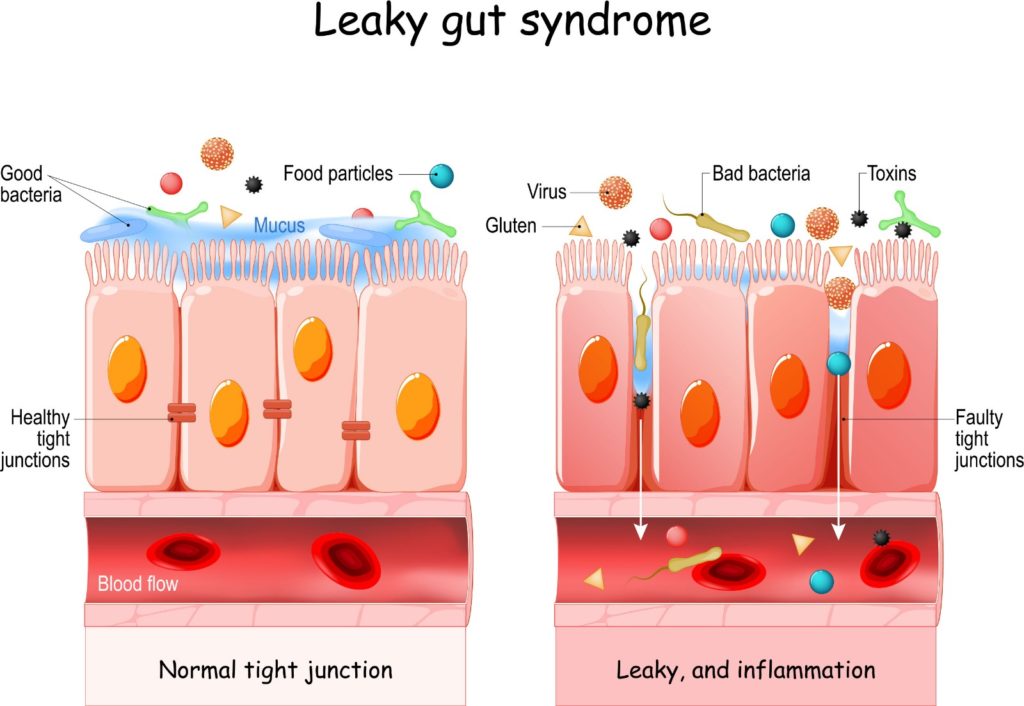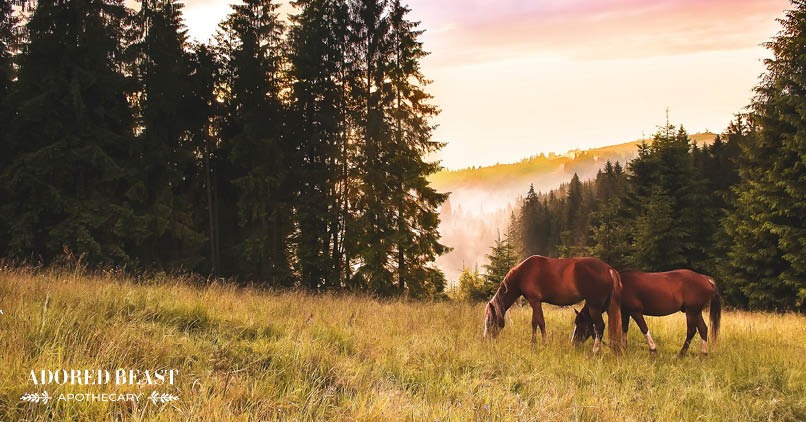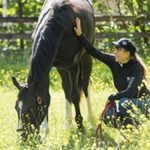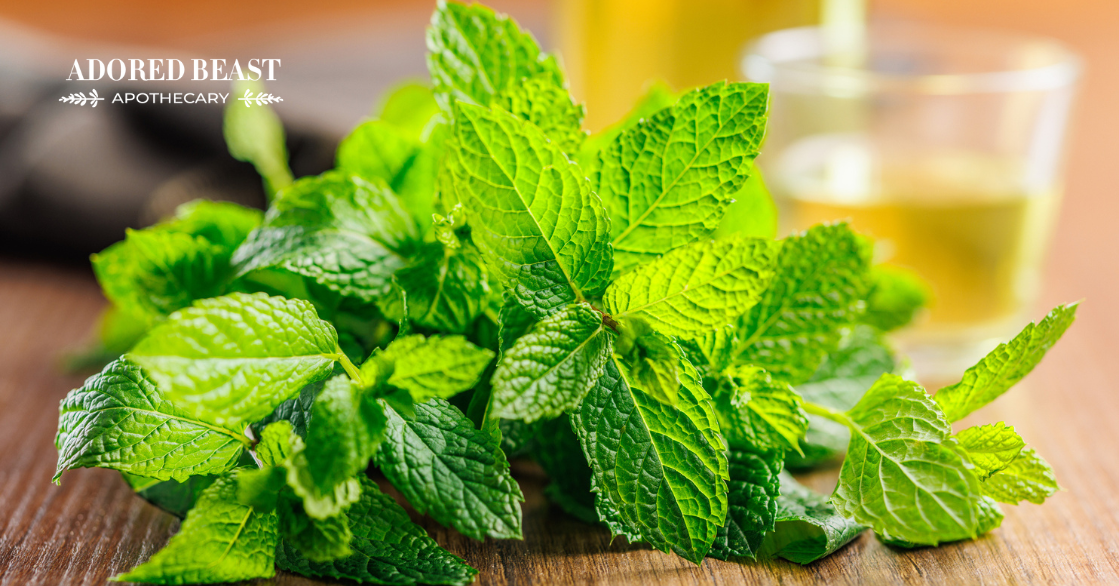Equine gut health is a subject seemingly shrouded in mystery. Ulcers and colic seem to be two painfully common problems among modern horses, and this doesn’t seem to be improving on any large scale. They’re chronic issues that require a multi-faceted approach in order to resolve. Conventional methods of addressing gut damage don’t always fix the issue, leading to recurring symptoms and further health complications. So why can’t we get on top of their gut health in a real and long-lasting way?
In recent years, the field of study into equine gastric (stomach) ulcers has expanded exponentially. We now know that even when ulcers are confirmed, the outcome is still variable and not an exact science when it comes to modern-day treatments. It’s also important to note that ulcers can only be viewed in certain parts of the digestive tract but they can form anywhere along it from the stomach to the bowel.
At the same time, the study of the gut microbiome has exploded in the past 15 years in both humans and animals. Science has revealed how integral our gut and microbiome health are to our entire well-being from the immune, urinary, and nervous systems to our metabolism and beyond. And…. that’s only the stuff we do know about! Imagine how much more there is to understand.
The gut and its microbiome play an integral role in an organism’s overall health, whether you’re an owl or a human or a horse.
Now, back to equine ulcers and colic…. These afflictions are only the end-stage of a deeper issue that has been going on for a long time: mucosal membrane damage and chronic inflammation of the gastro-intestinal epithelium. The epi-what? Let’s start from the beginning.
Do Wild Horses Get Ulcers?
Where wild horses still exist, studies have been done to find out if they too are suffering from ulcers to the same degree as domestic ones. And, the answer seems to be no. While some wild horses suffer from ulcers, the degree of prevalence and severity is significantly less than horses managed by humans. (1) (2) (3)
So what is nature doing for these horses that we cannot? Well, there are a lot of things. It’s not our job, nor should it be our goal, to do better than Mother Nature herself. But we can aim to embody her. We really must look to animals living in their natural state to learn about how we can do better for our own. Understanding the stressors that we place on domestic horses and the underlying mechanics of ulcer development leads to an understanding of the solutions.
The Synergy of Equine Gut Health
The healthy equine gut is a beautiful biological system. It is a product of the horse’s ancestry. Anatomically and physiologically, they couldn’t really be more perfect for their role on Earth. Horses are one of nature’s great sculptors as are the other nomadic, hooved creatures on the planet. They shape the landscape with their movements, their foraging habits, and their social hierarchy. They are known as hind-gut fermenters, because they digest extremely fibrous plant matter and obtain nutrients from it with the help of their highly specialized gut and its trusty microbiome.
A happy gut will have a resilient GI wall (the epithelium!), a well-established mucosal lining, and diverse microbial community. Its function isn’t just to digest food. The gut is SO much more than that. It also:
- Protects your horse’s internal homeostasis from incoming environmental insults including foreign matter, toxic chemicals, pathogenic bacteria and viruses
- Decides what elements of food and water should enter the bloodstream and which ones should be expelled
- Makes up at least 80% of the immune system, modulating immune response
- Catalyzes and completes countless metabolic pathways
- Produces vital nutrients for the host cells (vitamin Bs, K, fatty acids and more)
- Plays a part nervous system function
- Plays a part in internal organ function
- Effects insulin regulation
- Effects gene expression
The list goes on…
And, the epithelium isn’t isolated to the gut. These linings exist throughout the body, including in the eyes, ears, nose, throat, lungs, urethra, vagina, blood vessels, brain, inner column of the spinal cord, and all of the internal organs. It’s mind-blowing, really.
The microbiome inside the mucosa sits directly on top of the epithelium. It has a symbiotic relationship with the equine gut cells. This means the cells of your horse’s gut can actually “talk” to the microbes and vice versa! They communicate back and forth to help keep the balance of homeostasis throughout the entire body.
This highly regenerative layer of cells is what speaks to the outside world, helping us adapt through our genetics. It’s one of the most resilient tissues in the body, regenerating fully every 2-6 days. This is the highest turnover rate of any cell in the body. (4) So, if it’s so highly resilient, why are so many horses having such a hard time regenerating their gut cells?
Signs Your Horse Might Have Ulcers
Horses can display a wide range of symptoms when they develop gastric ulcers including:
- dull coat
- lethargy
- weight loss
- diarrhea or dry manure
- gut pain
- behaviour changes eg. aggression and fear
- colic, especially recurring colic
- increased liver or kidney values
- chronic inflammation (eg. arthritis, laminitis, allergies, asthma)
How Does Your Horse Get Ulcers?
Here are some of the reasons human-managed horses get ulcers far more often and more severely compared to wild horses:
- lack of social interaction
- lack of movement and foraging
- repeated antibiotic use
- NSAID drugs (non-steroidal anti-inflammatory drugs)
- starch and sugar in the diet
- the presence of glyphosate from GMO horse feed ingredients
- nutrition deficiencies
- increased mental stress (eg. sudden change of environment, showing, fear-based training, etc.)
A combination of these issues can increase ulcer risk substantially so it’s really important to assess the overall risk your horse is facing with their physical and mental stress.
For a deeper dive into all the research on ulcer risks, check out our equine ulcer blog here.
How Gut Damage Happens
Damage to equine gut health doesn’t happen overnight.
When our vet finally gets to the stage of scoping a horse to check for ulcers and diagnosing them, they’ve been there a while. It’s not like the ulcers arrived last week and tomorrow you’re going to get them fixed. Ulcers take time to develop with consistent insult to the linings of the gut. They also take time, and a deep understanding of their development, to heal. If you don’t work to eliminate the reason for the ulcers, you’ll keep chasing your tail trying to help your horse.
Let’s go back to the fancy word I mentioned before: the epithelium.
When epithelial cells are healthy, they are tightly bonded together, disallowing foreign fluids and materials to get in between them and into the bloodstream below.
However, if the mucosa becomes damaged or destroyed, that’s when things go wrong. The mucosa is made by special secretory cells (goblet cells) within the epithelium. But they can only secrete so much at once and if they become damaged, they can completely stop working. Then, the tight junctions of the gut wall start to break apart which is what we now know as “leaky gut syndrome” or dysbiosis.

Let’s break the entire process of dysbiosis and ulcer development down into stages:
Stage 1: Healthy mucosa, microbiome and epithelium work in harmony promoting a healthy immune system, digestion, and metabolic function.
Stage 2: Inflammatory stress or toxic insult to the mucosa result in a loss of protection or destruction of the microbiome and the epithelium. In the absence of the mucosal barrier, the microbiome and the epithelium can be exposed to gastric juices (acid), pathogens, and toxic material.
Stage 3: Prolonged exposure to acid and toxins causes the tight junctions of the epithelium to break apart, leaving tiny holes in the gut. As the insults continue, the holes grow: ulcers.
Stage 4: Inflammation is exacerbated by prolonged exposure to acid and waste, leading to continued erosion of the gut lining, impairment of its regenerative process, waste entering into the bloodstream and circulating around the entire body. This can lead to systemic inflammation and elevated kidney and liver values in severe cases. (5) (6) (7)
Understanding The Limitations of Conventional Treatments for Ulcers
Generally, if a horse is diagnosed with ulcers a veterinarian will prescribe two drugs: omeprazole to reduce gastric acid and sucralfate as a mucosal adherent that protects the GI lining from further damage. Gastric acid worsens the ulcer and can exacerbate the issue if left untreated so it’s important to get your veterinarian’s assistance if your horse has a severe case.
But these drugs won’t fix equine gut health. And they’re not going to fix the reason why the ulcer appeared in the first place.
The problem is that drug intervention works literally as a Band-Aid for the problem and doesn’t address the actual cause of the ulcer itself. Often times, horses go through an expensive 30-60 day treatment protocol (with a $1500-3000+ price tag) with temporary improvement often followed by recurrence as the gastric acid begins to build and the synthetic pharmaceutical coating disappears. Of course, this depends on several factors including all of the risks listed above and the severity of the ulcer at the time of treatment. (8) (9) (10) It can be a very expensive and stressful process, not to mention life-threatening if colic symptoms begin to appear.
If you treat your horse but don’t address why their gut is damaged in the first place, you and your horse could go on a very long and stressful health merry-go-round.
So what can we do for long term success along with conventional care options for equine gut health? To understand this, we have to understand what happened before the ulcers appeared.
Solutions for Long Term Success: Restoring Equine Gut Health
While there are times when pharmaceutical intervention is necessary for your horse’s well-being, it cannot “fix” the problem by itself. You should always have a long-term prevention plan in place to improve equine gut health and avoid recurrence. So how do you do that? Here are some simple ways you can start:
1. Diet Yes and No Checklist
YES:
- high fibre forage
- low starch and low sugar
- fresh species-appropriate foods
- fresh or dried nutritive herbs
- customized protein and fat intake based on life stage, workload, and health status
- fresh forage and DIRT!!!
- plant-based omega 3 fats
- natural-source nutritional supplementation when indicated
NO:
- high starch and high sugar
- highly process foods
- GMO ingredients sprayed with the herbicides glyphosate and dicamba (wheat, corn, sugar beets, soy, alfalfa, canola, etc.)
2. Feeding The Epithelium and the Mucosa
In severe cases, it’s going to take a multi-level approach to restore the epithelium and the mucosal layer. This step is also integral to restoring the microbiome. Each layer needs supportive nutrients to come back online. Some well-studied foods, nutraceuticals and herbs used for this purpose are:
- omega 3 fats
- peppermint
- slippery elm bark
- liquorice root
- l-glutamine
- aloe vera
- n-acetyl glucosamine
- mucilage (eg. chia seed, marshmallow root, fenugreek seed powder)
3. Establishing and Feeding the Microbiome
As you restore the mucosa, the microbiome can also come back to life. Probiotics are a fantastic solution but they aren’t all created equally. Be sure to include as many beneficial strains as possible to increase diversity of the entire community. And, be sure to include species (equine)-specific strains of probiotics along with access to soil and prebiotic fibres to help establish them.
Equine-specific probiotics are those isolated from the manure of healthy horses and tested for their specific health benefits. These microbes are specific to the ancestral physiology of the horse. They’re a brand new calibre of probiotics specifically studied to benefit the equine species.
Ingesting healthy soil during grazing periods can also give your horse access to thousands of beneficial microbes.
4. Reducing Stress
You cannot make a lasting impact on your horse’s gut health without reducing their stress. To learn more about stress reduction solutions for horses, click here.
Ulcer management requires a deeper-acting approach than the current standard. With a focus on improving equine gut health, we can get there. For all the joy they bring us, we can and should do better for our horses!
References:
- Equine Veterinary Education: A comparison of the prevalence of gastric ulceration in feral horses and domestic horses in the UK, 2015
- Prevalence of gastrointestinal ulcers in freely roaming Prewalski horses in Hungary, 2015
- The Horse: Gastric ulcer prevalence in feral, domestic horses compared, 2015
- Veterinary Pathology: Epithelial cell shedding and barrier function, 2015
- Diseases: Role of gut dysbiosis in liver diseases. What have we learned so far? 2019
- Pediatric Nephrology: Gut microbiome and kidney disease: a bidirectional relationship, 2017
- The Horse: It’s All Connected: Bodywide Inflammation in Horses, 2018
- Equine Veterinary Journal: Efficacy of omeprazole paste in the treatment and prevention of gastric ulcers, 1999
- Canadian Veterinary Journal: Efficacy of a paste formulation of omeprazole for the treatment of naturally occurring gastric ulcers in training Standardbred racehorses in Canada, 2003
- Journal of Veterinary Internal Medicine: European college of equine internal medicine consensus statement – Equine Gastric Ulcer Syndrome in adult horses, 2015












